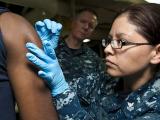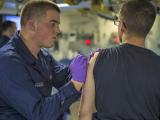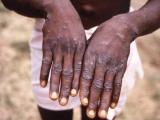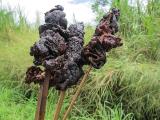May 17, 2007 (CIDRAP News) – The US Centers for Disease Control and Prevention (CDC) today released a detailed report about a 2-year-old Indiana boy who is recovering from a severe eczema vaccinatum infection contracted through contact with his father, a soldier who had recently received a smallpox vaccine.
The report, published in the May 18 issue of Morbidity and Mortality Weekly Report (MMWR), said the boy's illness is the first reported eczema vaccinatum case in the United States since 1988. The boy's father received his first-time smallpox vaccine on Jan 27, 2007, despite his history of childhood atopic dermatitis and contact with household members who have eczema (two of his three children), both contraindications to vaccination, the report said.
Vaccinia, a rare cutaneous and sometimes systemic reaction to smallpox vaccination that can occur in vaccinees or in close contacts of vaccinees, has been reported more frequently in the medical literature since the US military revived its long-discontinued smallpox vaccination program in late 2002. As of March 2007 the US Department of Defense said it had vaccinated about 1.2 million US service members deployed to the Middle East and other areas considered high-risk.
The father's overseas deployment was delayed, so he made an unplanned visit to his family in Indiana on Feb 16. During his 5-day visit at home the father said he kept the vaccination site bandaged and that the scab had separated before he returned home. During the visit he said he hugged and wrestled, bathed, and slept with his son, who had severe eczema and a history of failure to thrive.
On Mar 3 the boy was taken to a small local hospital in Indiana after a papular vesicular rash developed on his face, neck, and upper extremities. He was transferred to a hospital in Chicago later that day because of the severity of his illness, and healthcare workers there instituted Contact Precautions, the authors noted. The boy's mother told the hospital that weeping skin lesions had developed on Feb 24 and that he had a fever 2 days before he was admitted to the hospital.
By Mar 7 healthcare workers documented that his rash had progressed to umbilicated lesions with an erythematous base on his hands, forearms, neck, chest, face, and knees, which involved about 50% of his keratinized skin, the report said. The next day the Illinois Department of Public Health laboratory performed polymerase chain reaction orthopox assays on his lesion specimens, and the tests were positive for orthopoxvirus DNA, which confirmed the clinical eczema vaccinatum diagnosis. The CDC confirmed the vaccinia diagnosis.
From Mar 8 through Mar 28 the boy was treated with immunotherapy and antivirals. He received vaccinia immune globulin (VIG) along with supportive care. Despite treatment his condition worsened on Mar 10. His medical team then administered cidofovir, an antiviral, and an investigational drug ST-246, which has been shown in phase 1 clinical trials to protect animals from vaccinia and other poxviruses, according to its maker, SIGA Technologies, Inc. The patient also received more VIG infusions, according to the MMWR report.
After about 1 week of aggressive treatment the boy began to improve. He was discharged on Apr 19 after 48 days of hospital treatment.
Early in the boy's hospitalization the medical staff noted that his mother had six vesicular lesions on her face, and more lesions developed on her right index finger and eyelid. She told the hospital staff that she had periodic acne flare-ups and that she had rested her cheek on her son's abdomen while he was hospitalized. The mother was voluntarily isolated in her son's hospital room, and after 3 days of VIG treatment her lesions started to scab over. A blood test determined that an immune response to the orthopox virus had not yet developed.
The family's two other children, one with a history of eczema, stayed with their grandparents during the boy's hospitalization, and neither has shown symptoms of vaccinia infection, the report states.
Public health officials interviewed family and community contacts who may have had physical contact with the father or child and monitored them daily for 21 days after their last possible vaccinia exposure. Of 23 family contacts and 73 healthcare workers, one person had a rash and one had a fever, but neither had vaccinia virus infection, according to the MMWR report.
An environmental assessment of the family's home was conducted during the boy's hospitalization, and public health workers found that many samples were positive for the vaccinia virus DNA. Cell-culture samples from three items contained viable virus, and the home was disinfected by steam cleaning carpets, disinfecting household surfaces with phenolics, and washing clothing and linen in hot water after a phenolic presoak.
In an editorial note that accompanied the account of the boy's case, the authors wrote that the investigation indicates the father transmitted the vaccinia virus to his son and that tertiary transmission could have occurred between the child and his mother, though fomite transmission from household objects could not be excluded.
According to a previous Chicago Sun-Times report, doctors said the sick boy's father didn't know he should stay away from his son after the vaccination. And a Chicago Tribune report said it was unclear why the soldier was allowed to have contact with his son so soon after the immunization.
The CDC emphasized that agencies which administer the smallpox vaccine periodically assess the effectiveness of educational materials for healthcare providers and those who receive the vaccines. The report said the US military is investigating the vaccinia case, which might prompt a reevaluation of screening and education procedures.
Data mostly from the 1960s suggest that eczema vaccinatum occurred in between 10 and 39 cases out of every million first-time smallpox vaccinees, according to the CDC. But widespread smallpox immunization today could result in a higher rate, because of the large numbers of people with immunity weakened by cancer treatment, other immune-suppressing drugs, and HIV.
CDC. Household transmission of vaccinia virus from contact with a military smallpox vaccine—Illinois and Indiana, 2007. MMWR 2007 May 18;56(19):478-81 [Full text]
See also:
Mar 18 CIDRAP News article "Son of vaccinated soldier has severe vaccinia infection"
CIDRAP overview of smallpox, including information on risks of vaccination
CDC smallpox site
http://www.bt.cdc.gov/agent/smallpox/index.asp



















